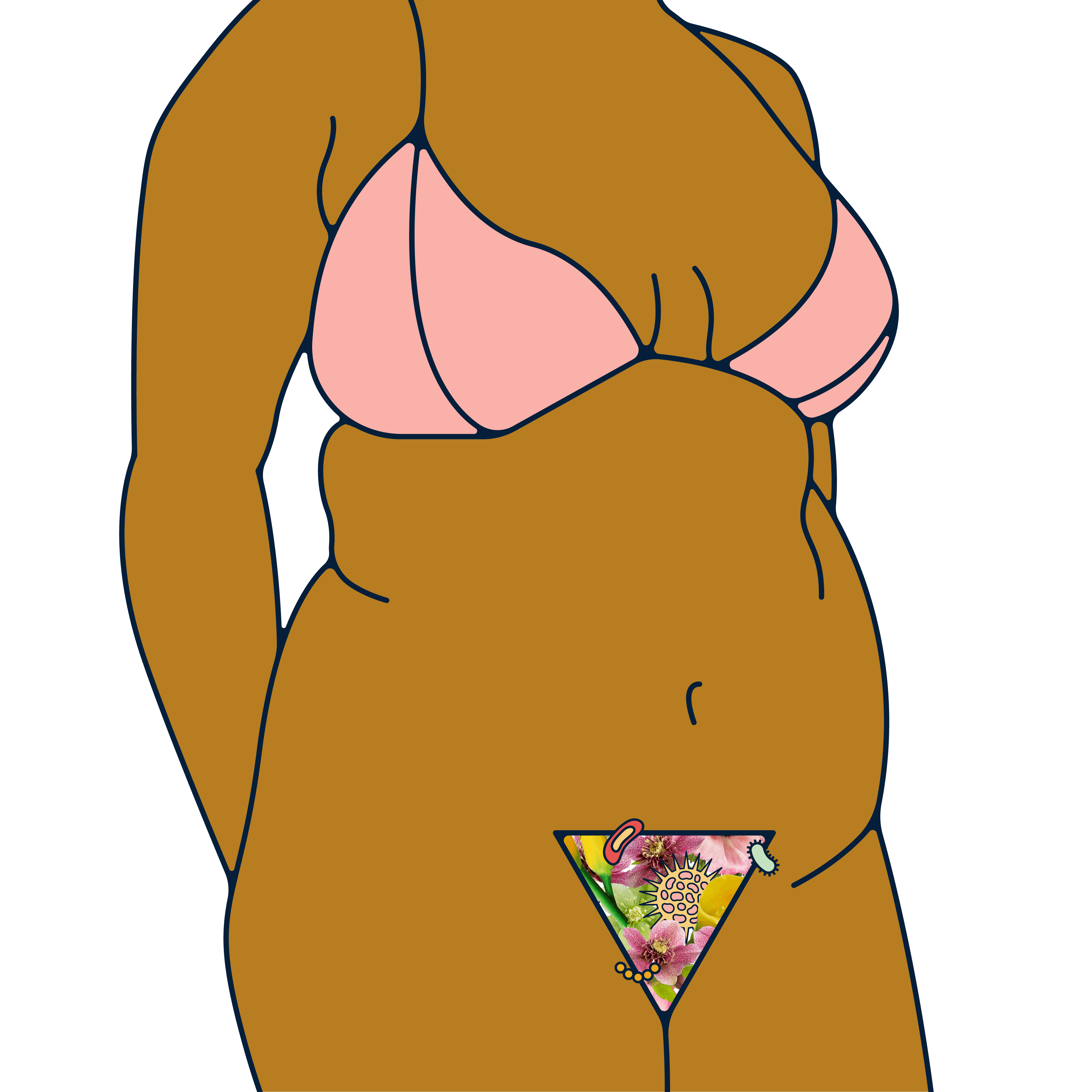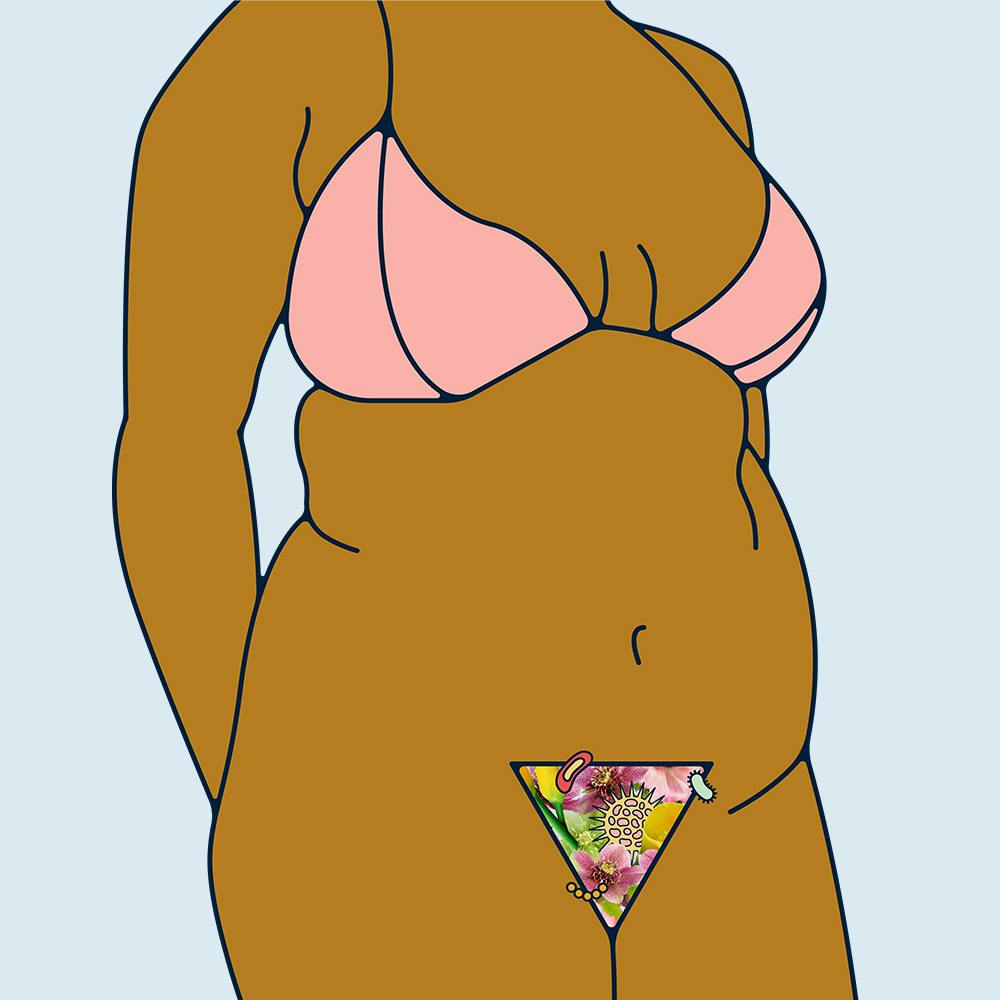Illustrated by Erin Rommel & Sabrina Bezerra
The vaginal microbiome is a complex melting pot of different bacteria, and the balance between them is not the same for all people with vulvas. In fact, Black women are disproportionately affected by infections like BV and thrush.
For hundreds of years, women were largely excluded from medical research that focused on their sexual and reproductive health. This male bias confined the scope of studies and interpretation of results to fit their narrow and patriarchal understanding of women’s health.
For those from minority communities, systemic racism and “misogynoir” are responsible for worse health outcomes across the board, and Black women have the biggest disadvantage.
What is BV?
Bacterial vaginosis (BV) is an overgrowth of bacteria within the vagina, usually Gardnerella vaginalis. Due to a shift in vaginal pH (typically above 4.5) that can cause inflammation and a grey discharge with an unpleasant smell.
This disruption within the vagina can also make you more susceptible to other vaginal infections and STIs, as well as preterm births.
Studies point to Black women being more likely to develop BV, with socioeconomic factors, microbiome differences, racial bias and barriers to healthcare access all presenting as influencing factors.
What is thrush?
Black women are also more likely to develop recurring or complicated thrush. This overgrowth of a yeast fungus species (called Candida albicans) within the vagina causes inflammation, itching or burning, and a thick cottage cheese-like discharge. Just about every vagina owner has been there at least once – it’s not pleasant at all.

Probiotics can help you protect your vagina from infections such as thrush and BV by replenishing your vaginal flora with good bacteria. Daye's ProViotics strenghten your vaginal microbiome so it can fight off harmful bacteria.


There are marked variations in vaginal flora by ethnicity, though it isn’t totally clear how this different vaginal bacteria balance contributes to a higher prevalence of vaginal infections.
Gynaecologist Dr. Christine Ekechi says that the understanding around varying vaginal flora among different ethnic groups is relatively new: “It’s not as simple as well, ‘if someone has X amount of melanin, then they will have a specific type of vaginal microbiome. It’s a lot more complicated than that.”
Vaginal bacteria play a crucial role
Most Lactobacillus species are protective of the vaginal environment, producing lactic acid that helps to keep the pH level below 4.5. This helps to create an acidity that stops different types of bacteria from overproducing, allowing them to exist at a beneficial level.
As part of their Vaginal Human Microbiome Project, a Virginia Commonwealth University study found that participants with white European heritage predominantly had vaginal flora that was dominated by Lactobacillus crispatus (gram-positive bacteria that produces lactic acid that contributes to a healthy vaginal microbiome). Black participants, however, had far more diverse vaginal floras. Other vaginal bacteria studies have also echoed these findings.

Vaginal microbiome of Black women
The most common type of bacteria found within the microbiome profiles from the Black participants was Lactobacillus iners, an unusual type of Lactobacillus bacteria that does not produce lactic acid or offer protection against vaginal infections in the way that other Lactobacillus bacteria typically do.
Lactobacillus iners is also associated with vaginal dysbiosis (where optimal vaginal flora is disrupted), as well as preterm delivery and premature amniotic sac rupture during pregnancy.
Gardnerella vaginalis was found within the vaginal microbiome samples of both ethnicity groups, but with greater frequency among the Black participants, along with BVAB1. Both these bacteria are known to cause BV infections.
The same study also compared the vaginal microbiomes of pregnant women by ethnicity, finding more Prevotella and Snethia bacteria in samples from Black participants (which have been found in amniotic fluid when preterm birth has occurred).
Similar results among diaspora and emerging regions
Research conducted in Europe, America and Australia have all echoed results that point to considerable differences in the vaginal microbiome of women from different ethnic groups.
Some have also indicated that there are smaller – but still marked differences – between Black women in western regions and those from, African, Caribbean and Latin American regions; Aboriginal women from Australian regions, and different African regions.
These are still thought to come be down to a combination of sociodemographic, behavioural, environmental and genetic factors.
A study on vaginal flora composition differences among ethnic groups in Amsterdam found that Lactobacillus-dominated communities were found in “90% of Caucasian, 80% of Asian, 65% of Hispanic, and 61% of Black women”.
Overall, the Hispanic and Black women who participated also had “a higher prevalence of BV, and a higher vaginal pH than Caucasian and Asian women”.

Lifestyle, genetic individuality and immunity affect vaginal flora
Dr. Ekechi points out that – while it’s now common practice to advise women based on their ethnic risk factors – everyone’s individual genetic make up and pre-existing conditions are likely to have a significant impact on vaginal flora, too.
“There are environmental trigger factors that can disrupt vaginal flora,” she says. “We know that there are lifestyle factors paired with factors like allergies that might increase someone’s chance of thrush or BV, like being allergic to the latex in condoms. “Sex itself disrupts natural vaginal flora, as can douching, which may proliferate certain bacteria or fungi species that can lead to infections.”
Use of lubricants with aggravating ingredients, sperm and penises (which are typically more alkaline than is ideal for optimal vaginal flora) can act as microbiome disrupters.
Women who sleep with women have a higher prevalence of BV because of the transmission of vaginal fluids during sex play. Some lifestyle factors, like smoking and alcohol, can have an impact on bacteria profiles, too.
Diabetes, autoimmune disorders & vaginal infections
Conditions that impact immunity, like diabetes or autoimmune disorders, leave people open to multiple bodily infections of any kind, including vaginal ones.
“With conditions like diabetes, the ideal acidity level of the vagina is disrupted, which in turn disrupts the vaginal microbiome,” says Dr. Ekechi. “Sugar impairment has an impact on this process.”
High blood sugar levels can cause frequent thrush, because glucose (sugar) acts like a feeding agent for Candida. Diabetes also causes the slower healing of cuts and tears, which create ideal growing spots for Candida if they occur in the vulva area.
Bridging the gender and racial divide is crucial
Not enough consideration is being given to how vaginal flora profiles commonly seen in Black women merge with barriers to healthcare access, racial bias among healthcare staff and within research to place Black women at greater risk of gynaecological and reproductive issues. This leads to a lack of tailored approaches to diagnosis, treatment and prevention
Dr. Ekechi emphasizes that it’s vital to address – not just acknowledge – these socioeconomic factors and existing racial biases. Changing health outcomes for Black women – from the initial contact to diagnosis to treatment plans – starts with medical or nursing school.
“By the time someone moves out of education into consultancy, racial biases are already heavily entrenched,” she says.
“The idea that there’s a genetic reasoning behind all health outcomes is common at this stage. Understanding around the social determinants of health tends to come later on. We have to start having the conversations that will move the dial on these issues.”






